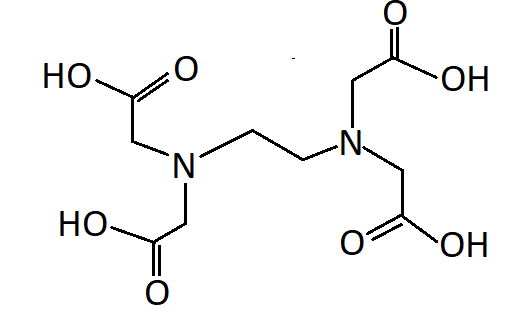
Which of the following represents hexadentate ligand?
A.EDTA
B.DMG
C.Ethylenediamine
D.None of the above
Answer
555.3k+ views
Hint:Ligands are atoms or groups of ligands that bind to a central metal atom to form a coordination complex. The nature of this ligand-metal bond can be ionic or covalent. Some ligands can form more than one bond with the metal atom, these are known as polydentate ligands.
Complete step by step answer:
-Denticity refers to the number of donor groups in the single ligand that can form bonds with the central metal atom.
- Ligand which has only one donor atom is called monodentate ligands, ligands having two donor atoms are called a bidentate ligand.
-DMG stands for Dimethylglyoxime. It binds with metal atoms with two bonds one with each nitrogen atom. Hence it is a bidentate ligand.

-Similar to DMG, ethylenediamine also has two nitrogen atoms as donor atoms and is a bidentate ligand.
${{{H}}_{{2}}}{{N - C}}{{{H}}_{{2}}}{{ - C}}{{{H}}_{{2}}}{{ - N}}{{{H}}_{{2}}}$
-Similarly, a ligand having six donor atoms is called a hexadentate ligand.
-EDTA refers to ethylenediaminetetraacetic acid. EDTA has two nitrogen atoms and four oxygen atoms as donor atoms. Thus it is a hexadentate ligand

Hence the correct option is A. EDTA is a hexadentate ligand.
Note:
EDTA imparts extra stability to the coordination complex due to its chelate effect.
Chelation is the property of polydentate ligands which means ligands that have more than one donor atom.
When a polydentate ligand bonds with the central metal atom or ion, it forms a ring. This ring formation because of the presence of more than one donor atoms is called chelation.
The ring formation or chelation enhances the stability of the coordination complex as compared to the one having no chelation, this effect is known as the chelate effect.
Complete step by step answer:
-Denticity refers to the number of donor groups in the single ligand that can form bonds with the central metal atom.
- Ligand which has only one donor atom is called monodentate ligands, ligands having two donor atoms are called a bidentate ligand.
-DMG stands for Dimethylglyoxime. It binds with metal atoms with two bonds one with each nitrogen atom. Hence it is a bidentate ligand.

-Similar to DMG, ethylenediamine also has two nitrogen atoms as donor atoms and is a bidentate ligand.
${{{H}}_{{2}}}{{N - C}}{{{H}}_{{2}}}{{ - C}}{{{H}}_{{2}}}{{ - N}}{{{H}}_{{2}}}$
-Similarly, a ligand having six donor atoms is called a hexadentate ligand.
-EDTA refers to ethylenediaminetetraacetic acid. EDTA has two nitrogen atoms and four oxygen atoms as donor atoms. Thus it is a hexadentate ligand

Hence the correct option is A. EDTA is a hexadentate ligand.
Note:
EDTA imparts extra stability to the coordination complex due to its chelate effect.
Chelation is the property of polydentate ligands which means ligands that have more than one donor atom.
When a polydentate ligand bonds with the central metal atom or ion, it forms a ring. This ring formation because of the presence of more than one donor atoms is called chelation.
The ring formation or chelation enhances the stability of the coordination complex as compared to the one having no chelation, this effect is known as the chelate effect.
Recently Updated Pages
A man running at a speed 5 ms is viewed in the side class 12 physics CBSE

State and explain Hardy Weinbergs Principle class 12 biology CBSE

Which of the following statements is wrong a Amnion class 12 biology CBSE

Two Planoconcave lenses 1 and 2 of glass of refractive class 12 physics CBSE

The compound 2 methyl 2 butene on reaction with NaIO4 class 12 chemistry CBSE

Bacterial cell wall is made up of A Cellulose B Hemicellulose class 12 biology CBSE

Trending doubts
What are the major means of transport Explain each class 12 social science CBSE

Which are the Top 10 Largest Countries of the World?

Explain sex determination in humans with line diag class 12 biology CBSE

Draw a labelled sketch of the human eye class 12 physics CBSE

How much time does it take to bleed after eating p class 12 biology CBSE

Suicide bags of cells are aEndoplasmic reticulum bLysosome class 12 biology CBSE




